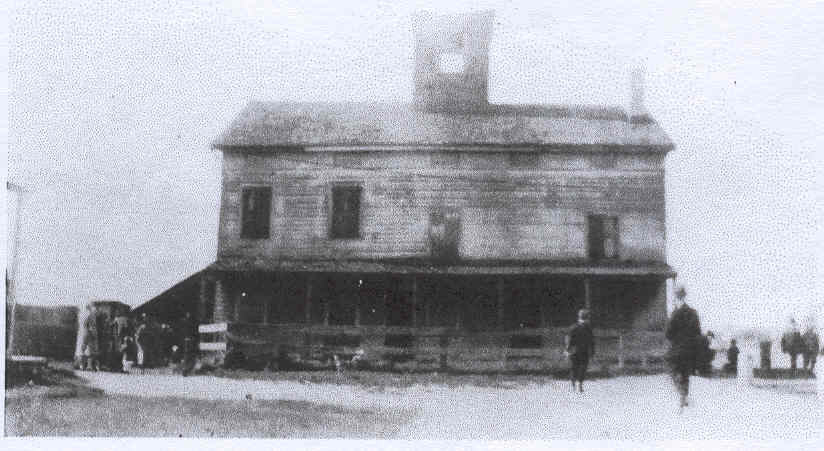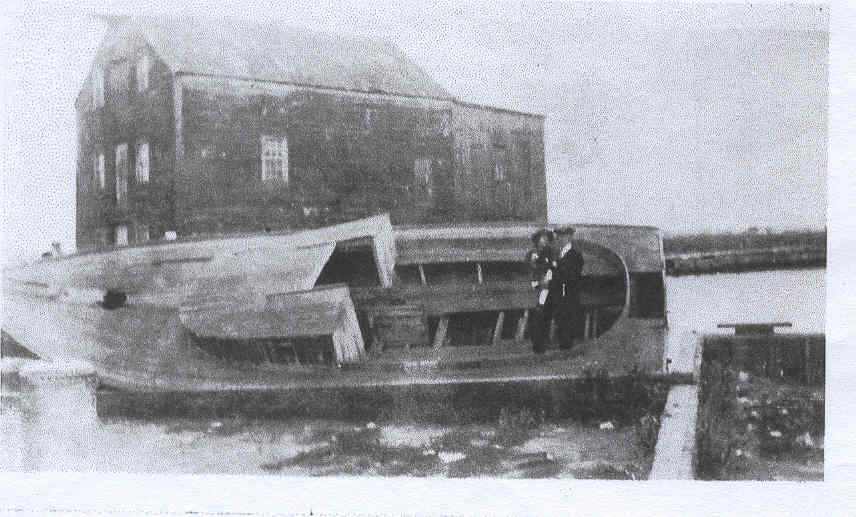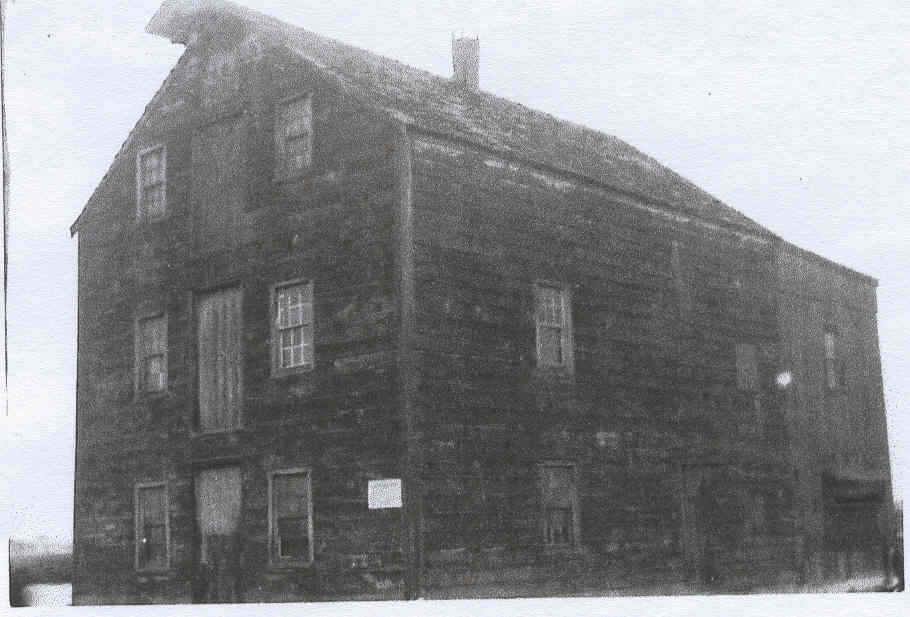Jacob Lott Van Wicklen's Mill

Photo of Van Wicklen Hotel/Mill from visit by family of David L. Van Wicklen, courtesy - Richard^10 Van Wicklen

Panoramic photo of the Old Mill [far right] from the foot of Crescent Street circa 1900 to 1910 or thereabouts. The name, David S. Van Wicklen appears on the front of the mill at the top and I believe the older gentleman in the center of the photo nearest to the large pole with a white shirt and hat and his back to the water...is Captain Richard L. Van Wicklen, brother of David S. Van Wicklen. This panoramic photo was sent via email on 10 Jan 2015 from Jacquelyn Mandell. Jackie presented this photo to her mother along with a copy of the Old Mill poem by Howard P. Bullis [see below] on the occasion of her 90th birthday. The photo reminded her of her happy childhood occasions at the Old Mill.
Like most other villages, New Lots had its gristmills, smiths, grocery, stores, bakeres, shoemakers, and wheelwrights. A prominent landmark in New Lots was the Red Mill, also known as the Vanderveer Mill, which was barn red and a prominent landmark. Another mill, known as the Van Wicklen Mill, was established on Bull Creek by one Van Brunt soon after the Red Mill. Until 1810, Bull Creek Mill stood at the second flood gate about a half-mile south of its newer site. In that year, the mill was taken down and with those timbers a new structure was built at the foot of Crescent Street on the east side of the roadway. The mill was owned by Jacob Lott Van Wicklen and became known as Van Wicklen's Mill and the Creek became known as Old Mill Creek. The state census of 1845 and 1855 reported the existence of two gristmills in New Lots. According to the 1845 census, the manufactured products of the two mills amounted, one to $4,770 and the other to $3,200. According to the 1855 census the two mills were about equal in their production. The Van Wicklen flour mill ground 8,000 bushels of wheat (values $12,000), producing 1,600 barrels of wheat flour worth $15,500. It employed two persons who received an average monthly wage of $50.
Landesman notes that early in the 1800s, Van Wicklen's Mill was owned by L. Van Wicklen. (Richard McCool believes this to
be Lott Van Wicklen and an obituary on Jacob Lott Van Wicklen confirms this to be Jacob Lott Van Wicklen. Richard goes
on to say that is was customary for Dutch men and sometimes women as well to go by their middle names.
From Peter Rapelje and his son, Jacob Rapelje...we get the following account of the Old Van Wicklen mill (as relayed to me via
email from Richard McCool)
Description of the Old Mill at the foot of Crescent Street, Brooklyn
This community consisted of the Mill itself, a two and one half story frame hotel with cupola, a few boat houses on each side of
the creek; I wouldn't say more than six to eight on each side.
The Old Mill ran north and south. At the south end it widened to form a landing. The bank of the creek at the landing was
protected by a timber bulkhead which ran about 150 feet southward from the southwest corner of the mill and then broke at
right angles westward for another 100 feet and then again at right angles southward to the beginning of the row of boat houses
on the west bank.
The Mill itself was a tide mill facing south, a two story frame building with a platform on the west side and double doors
opening from the mill building upon a platform and another door in the second story with a loading beam above it. The
platform was used for receiving the grain from the farm wagons and shipping the four and bran. The undershot wheel was on
the east side of the flood gates opening. As I understand, the mill pond was more or less artificial and was an offshoot of
Spring Creek to the east. The water for the mill was held back by two flood gates, one at the east end of the mill and the other
down about 800 feet south of the mill across the original Spring Creek. The straight north and south creek to the Old Mill was
a dugout. Just south of the mill and flood gate at that point was the basin where the larger boats were anchored. This basin was
roughly 200 to 300 feet square.
When I first remember, there were not more than a half dozen of the larger sloops anchored there. One of them was the
Cornelia, owned first by Dave Van Wicklen and later by Andrus Forbell. At one time Dick Van Wicklen's schooner, Scud, was
anchored there. Sand boats and manure boats came up the creek from time to time.

(David Langdon - husband of Nell Van Wicklen -
and his daughter, Helen, standing inside an old abandoned boat by the VW Hotel.
Is this perhaps either the Cornelia...or the Scud, referred to above? 1922
photo, courtesy of Richard^10 Whitney Van Wicklen)
Our boat house, at first, was a small lean-to on the east bank, about the third boat house down. Later we occupied the old
SoSo house on the west bank, just north of old Henry's place. We used to ride down with the men folks when they took the
grain down for grinding.
The Old Mill house was kept by Van Wicklen. I remember two of the older generation of Van Wicklens. One was Lott Van
Wicklen, but I have forgotten the other. The Mill House or hotel faced south. It had a porch running all along the front. A hall
ran through the center of the house, the saloon was to the west of the hall and occupied the whole front of that side. The bar
was against the north wall.
A long shed for horses and wagons was northwest of the hotel and ran north and south, opening to the east. The barn, with
stables, was at the north end and the ice house was at the south end. A narrow driveway ran between the hotel and the ice
house.
We always had soda and bolivers when we went down to the Mill in the old days.
When we were old enough, Uncle Nick and Pop and sometimes uncle Pete would take us out fishing several times during the summer. Although we always had a small sailboat in the boat house, built by Mr. Soper, we did not go out in it because there
were too many of us. We hired two row boats from Van Wicklen.
In the fall of the year, when farm work was not so pressing--say the later part of September and through to the end of
November--my father and Uncle Nick, sometimes Uncle Pete, Will Hegeman, Ferd Hegeman, and sometimes others, would hire
Andrus Forbell or Dave Van Wicklen to take them out in the Cornelia for blue fish and later in the year for cod fish and ducks.
I have seen them come home with a wagon load of two to three hundred seven-to-nine pound blue fish.
It was not until after 1890 that the Old Mill began to expand. In the 1900s both banks of the creek were lined with boat houses
right up to the flood gates on the east side and around in Betts Creek on the west bank. Also, buildings were erected on the east
side beyond the old flood gates and a cluster not far from the mouth of the creek. On the west side, a settlement sprang up on a
dugout at Kiendlsville.
By 1900 there was no use for the mill proper as all grain raising in the community had ceased. The flood gates began to be
neglected and the creek slowly degenerated into a mud hole.
From our house, we had three routes to the Old Mill. One by the way of New Lots Road eastward to Elderts Lane thence south
through Plunders Neck. (By the way Plunder's Neck was allegedly named that during the Civil War when soldiers quartered
there plundered the Old Mill people of their turkeys and chickens.**Apparently
this little bit of anecdotal information is mistaken in that Plunder's Neck is
referred to as such in Town of Flatbush records dating from 1685--see source
section below) From here there was a sharp bend to the west about three
quarters of a mile down and then straight south to the Mill. Andrus Forbell and the Sopers lived on the west side of the road
and some other Forbells on the east side. Some of these were baymen and some market gardeners. The land to the east of the
Old Mill was well adapted to market gardening and was intensively filled by the gardeners, many of whom were German.
Among these were the Von Drules, Sopers, Myers, Torborgs, Borgsteads, and others, all very thrifty and skilled gardeners.
There was a small store in the neighborhood of Forbells for years and years. It might have been termed the general store of the
neighborhood. We stopped there at times for soda and candy.
The other route to the Old Mill from our house was along the New Lots Road to the east line of our property, then south to
what we then called Gaynor's woods, then through this wood coming out at what was then Frank Forbell's home which was
where the road formerly described broke directly south in the straighaway to the Mill.
Just as we came out of Gaynor's woods, and before we reached Frank Forbell's, a lane ran to the south to a small community
of colored folks. It was here that the Treadwells that worked for us lived. They gathered here at the end of the slave days in this
state.
The story goes on to describe other routes to the mill, memories of McKee's store on Linwood Street, a timber bridge over
Betts Creek and tall oaks, chestnuts and hickory trees in the area.
Peter Rapelje passed away 27 May 1951 at the age of 78. Few remnants of the New Lots of his youth remain today. The
Reformed Church which underwent major restoration in recent times remains active, and the New Lots Cemetery remain. The
neighborhood today is a very poor area, though some efforts are succeeding to rehabilitate and renew the area.
The Old Mill, also known as Van Wicklen's mill was first erected circa 1760 by a Van Brunt. On a map "protracted to 10th
November 1797" by Jeremiah Lott, it is designated at Titus Mill. It was taken down in 1810 and rebuilt of the same timbers at
another location, apparently in close proximity to its former site. This is the structure remember by Peter
Rapelje. --commentary by Richard McCool from email of 1 September 1999

(1922 photo of rear side of Old VW Mill, courtesy of Richard^10 Whitney Van Wicklen)
Poem about the Old Van Wicklen Mill
The Old Mill - by Howard P. Bullis
Source:
Email correspondence from Richard A. McCool to J. Van Wicklin (1 September 1999). Richard McCool cites the following:
1. "A History of New Lots, Brooklyn--to 1887" by Alter F. Landesman; 1977, Kennikat Press, Port Washington, NY 2. Peter Rapelje's Remembrances of Old New Lots, Brooklyn with entries from the 1892 and 1893 Diaries of Sabra Louisa
Crossman Duryea
Brooklyn Eagle, 15 August 1886, page 15 -
A View of the Old Mill: The interesting relic of the twenty-sixth ward (This
is a three page, detailed article that addresses the ancient history of the mill
as well as some of the celebrities and personages who visited the site. For
example, in 1810 the father of the late Senator Hency C. Murphy rebuilt the
mill. During pre-revolutionary times in the days of the early Dutch settlers, an
Indian named Ploudin ran a mill there until the British attempted to confiscate
it, at which time Ploudin set fire to the property. Jacob Lott Van Wicklen
became proprieter of the property in 1840. It had been sold earlier to John
Forbel, who I imagine is a forebear of Jacob's daughter-in-law, Mary Ellen
Forbel. The article describes the site as good for fishing and game hunting and
frequently visited by celebrities and politicians. Several race horses of note
were stabled there at one time (Knight Templar, Rambler, King Nero), and prize
fighters used to train there.
The name "Plunder's Neck" dates before 1685
(courtesy Carole Kenney via Oct 2005 email) History of the Town of
Flatbush, in Kings County, Long Island, p. 4 - "...from thence
with a southerly line, to the kill or creek by the east of the Plunders Neck,
and so along the said kill to the sea...signed with my hand, this twelfth day of
November, in the first year of his majesty's reign, Anno Domini, 1685."
17 Sep 1910 Brooklyn Daily Eagle article titled "Old Mill Mardi Gras. Jamaica Bay Resort to Start Celebration Tonight with Big Day Tomorrow."
The Mardi Gras and the centennial celebration at Old Mill, on Jamaica Bay, at the foot of Crescent Street begins tonight. At 8 o'clock the coronation exercises will be held. Commodore G.A. Cooper will be the orator. King Chris Lammers and Queen Cora Dudoire will then proceed to visit the provinces over which they will reign, including Pleasant Point, Davidstown, Kiendleville and Kaiserburg, where receptions will be held. Tomorrow morning at 9 o'clock the naval parade will start in which there will be over 200 decorated boats. The King and Queen will be conveyed on the sloop Cornelia, Captain Dave Van Wicklen commanding. At noon the King and Queen will be guests at a dinner with President John G. Torburg at the Crescent Hotel at Liberty avenue and Crescent street. At 2 P.M. the land parade will form with George A. Simon as grand marshal, followed by the officers and members of the Mardi Gras Association escorting the majestic party attendants. The Pleasant Point Volunteer Pump and Hose Company, The United States Volunteer Life Saving Corps in command of Captain Peter T. Nuhn with Captain Perkins of the Pleasant Point division, the Old Mill Yacht Club, Commodore William E. Powers commanding, and the Kiendleville Mardi Gras Association will be in line. At 4 o'clock there will be water sports, including an endurance swimming race from the Canarsie breakwater to the Old Mill Yacht Club house at Davidstown. In the evening the Old Mill will be illuminated and there will be dancing and other amusements.
Article written [re: 1966] by Frank McLaughlin, grandson of Ida^7 Van Wicklen, daughter of Jacob^6 Lott Van Wicklen (following two articles courtesy of Richard^10 Whitney Van Wicklen)
Wampum Deal - Canarsie's Old Mill was a real one. Even the Indians around there brought corn to be ground by Jacob Lott Van Wicklen, the only miller for miles around. Here is how it began:
My great great grandfather came from Holland. [although not directly as these genealogy pages have determined] An early settler in Nieuw Amsterdam, he became a fur trapper. His son, Jacob Lott Van Wicklen, named Lott for his grandmother, was born there.
When Jacob married, he acquired all of New Lotts in a trade with the Iroquois Indians. He built the Old Mill and handshaped the water wheel spokes himself.
The property became known as New Lotts for Jacob's grandmother's maiden name. Jacob and his wife had three children: David, Richard, and my grandmother, Ida. Ida was born in the Old Mill on March 19, 1884, when the only approach road was Elder's Lane, from the foot of Crescent St.
The mill and considerable property were owned by my family from 1821 to 1923. My pleasant memories include going to Brooklyn when grandma collected rent from land tenants. We would go on a shopping spree along Broadway and in that old wonderland, Batterman's department store. Afterward, we would see the play at the old Alhambra Theatre. I hope readers who remember the Old Mill will enjoy reading its early history. I would like to hear from them.
Daily News, Tuesday May 5, 1966 in "I remember Old Brooklyn" a response to "Wampum Deal" article
Race Sailor: Dear Frank McLaughlin; My nephew sent me a clipping of your Old Mill memory. Well, I lived there quite awhile. In about 1890 my family rented property from Dave Van Wicklen and built our home--you could not buy the land.
I joined the Old Mill Yacht Club when it started. The barrel on a pole at the creek mouth marked Rum Point. The Old Mill, the Mill Pond and Dave Van Wicklen's house and barn were all quite close to one another.
Abe, the colored man who worked for Van Wicklen would cut ice on the pond for summer use at Van Wicklen's bar.
And I sailed quite a few boats in races you mentioned--for the Old Mill, Bergen Beach, Jamaica Bay, Canarsie, and Belle Harbor Yacht Clubs. I sailed the Allons for owner George Congery, the Boy Amaranthe for Wolf and a good many more. I sailed Tom Boy against a lone rival from the Rockaway Point buoy to Sandy Hook Lightship to Scotland Lightship and back--a triangular course. I believe we won by 22 minutes. I forgot to mention I was born May 25, 1885 and I am 80. --Joseph Tisso, N. Ft. Myers, FL